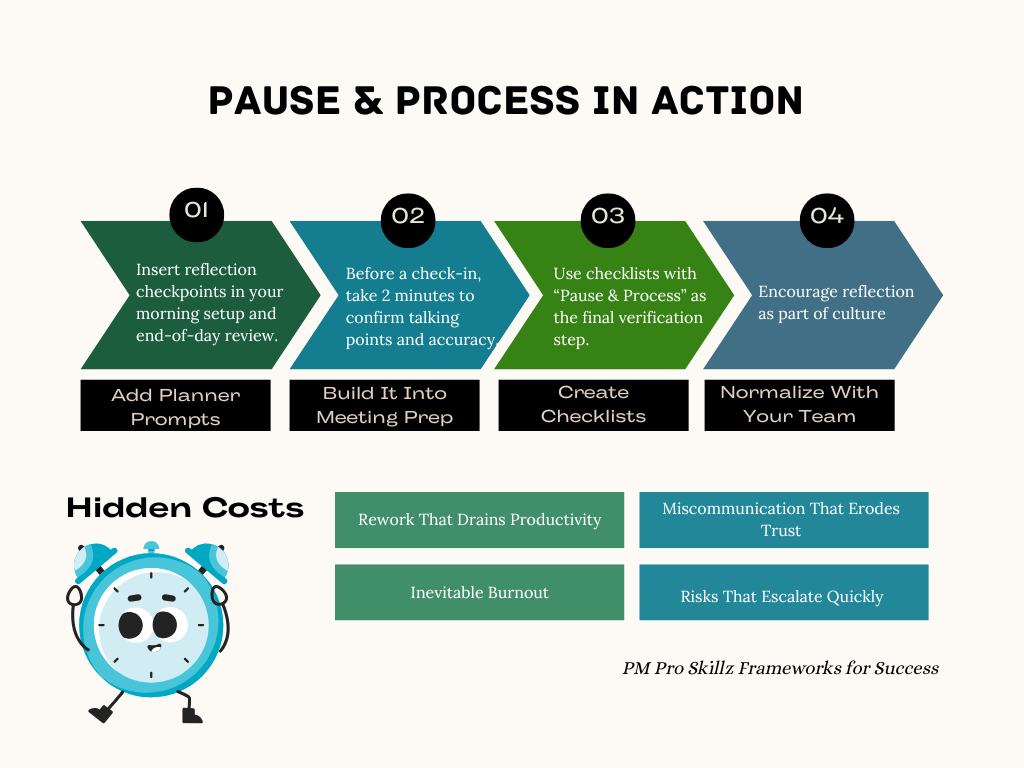Pause & Process: The Simple Habit That Prevents Costly Project Mistakes
Protect your credibility. Learn how a 60-second “Pause & Process” habit can prevent rework, miscommunication, and burnout in projects.
Iyanna Trimmingham
10/2/20254 min read


It's 4:47 PM on a Friday. Your finger hovers over the "Send" button on a project update email to your executive sponsor. You're exhausted, the week has been brutal, and you just want to close your laptop and start the weekend.
You click send!
Monday morning, you realize the budget figures were from the previous quarter. Now you're drafting an awkward correction email, and your sponsor is questioning your attention to detail.
Sound familiar?
That 30-second pause you skipped on Friday afternoon just cost you credibility, time, and mental energy. And here's the thing: this happens to all of us. Not because we're careless, but because we're moving too fast.
The Hidden Cost of Moving Fast
It’s not that speed is bad, it’s that unchecked speed turns into risk. In project management, speed is celebrated. Deadlines loom, teams expect quick decisions, and stakeholders want results yesterday. But here's what nobody talks about: speed without reflection is expensive.
One small oversight cascades into bigger problems. A miscalculation in scheduling means reassigning resources and reissuing timelines. A missed detail in a client brief creates misaligned expectations and lengthy realignment meetings. Before you know it, your team is stuck in "fix-it" mode, burning energy on corrections instead of making progress.
Research backs this up. Studies on project failure consistently point to unclear requirements and miscommunication as top causes, both preventable with better checkpoints.
The solution? It's simpler than you think.
What Is a "Pause & Process" Moment?
Think of it as a micro-checkpoint for your brain.
Instead of running on autopilot, you stop for 30-60 seconds and ask yourself three questions:
Am I confident in this step?
Do I have the information I need?
What's the risk if I move forward without reviewing?
That's it.
This isn't procrastination. It's not overthinking. It's intentional reflection that prevents the kinds of mistakes that require hours or days to fix later.
Before you send that email, you take 60 seconds to cross-check key metrics with your dashboard. That pause is the difference between building stakeholder trust and sending a correction that raises red flags.
Before you finalize a project timeline, you pause to confirm dependencies. That moment saves you from the chaos of missed deadlines and frustrated team members.
Why Skipping the Pause Costs You More Than Time
When you skip reflection, you don't just lose minutes, you lose credibility, energy, and momentum. Here's how:
Rework Drains Productivity: Fixing mistakes takes longer than doing it right the first time. A rushed decision on resource allocation might mean three rounds of schedule revisions, tense conversations with your team, and explanations to leadership about why timelines shifted.
Miscommunication Erodes Trust: A detail you missed becomes a gap in expectations. Suddenly you're in damage-control mode, managing frustration and realigning everyone to the same page. Trust takes months to build and moments to break.
Burnout Becomes Inevitable: Constant corrections wear people down. When your team spends their energy backtracking instead of innovating, morale suffers. Creative problem-solving disappears. You're all running to stand still.
Here's the truth: most project failures aren't dramatic. They're death by a thousand small oversights, each one preventable with a single moment of reflection.
How to Build the "Pause & Process" Habit
The beauty of this technique is its simplicity. You can start using it today with these three steps:
Step 1: Pause
Before you finalize anything; an email, a project plan update, a deliverable sign-off, stop for 30-60 seconds.
Physically step away from your screen. Take a slow breath. Create mental space between action and reaction.
Step 2: Process
Run through your reflection questions:
Is this accurate and aligned with project goals?
Do I have everything I need to proceed?
What's the potential impact if something's wrong?
* If anything feels incomplete or uncertain, that's your signal. Don't force through, clarify first.
Step 3: Proceed
Once you've reviewed, move forward with confidence.
That pause wasn't wasted time. It was insurance against mistakes that would cost you far more later.
Make It Stick: Practical Ways to Embed This Habit
Like any habit, "Pause & Process" works best when it's built into your routine. Here are four ways to make it automatic:
Add Planner Prompts: If you use a daily planner, add a reflection checkpoint to your morning setup and end-of-day review. Make it a ritual.
Build It into Meeting Prep: Before any team check-in, take two minutes to confirm your talking points and verify your updates are accurate.
Create Checklists: Pilots and surgeons rely on checklists to prevent catastrophic errors. Borrow their approach. Add "Pause & Process" as the final step before any critical action.
Normalize It with Your Team: Make reflection part of your team culture. When someone's rushing to finalize something, suggest: "Let's pause and confirm this before we move forward." That small shift changes rushed decisions into thoughtful ones.
Real-World Impact
The difference this makes is tangible:
During an ERP system migration, a project manager paused before cutover to confirm data backups and test results were complete. That two-minute review prevented a disastrous rollback that would have cost the company days of downtime.
When developing new SOPs, a team lead took five minutes to verify process roles before publishing. That pause saved multiple rounds of corrections and kept the team's credibility intact.
In everyday life, double-checking your grocery list at checkout prevents the "I forgot the milk" frustration when you get home.
The pattern is clear: a small pause prevents big problems.
The Trust You Build
Here's what happens when you make "Pause & Process" a consistent practice:
Stakeholders notice. You become known as the person who catches issues before they become crises. Your reputation shifts from "busy" to "reliable." And in project management, reliability is everything.
You also gain something invaluable: peace of mind. You can move forward knowing you've done your due diligence. The nagging "did I forget something?" anxiety disappears.
Trust is the currency of successful projects. Every pause that prevents a mistake deposits more into your credibility account.
Try It Right Now
Before you move on from this article, I want you to try something.
Think about the next action you're planning to take today. Maybe it's sending an email, updating a status report, or approving a deliverable.
Before you do it, pause for 60 seconds. Ask yourself those three questions. See what you notice. That one minute will save you far more time than it costs.
In a world that glorifies speed, precision is your competitive advantage.
What mistake did a simple pause save you from this week? I'd love to hear your story!

